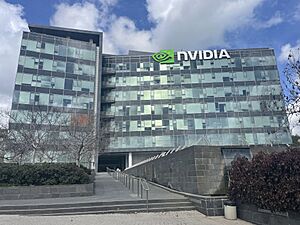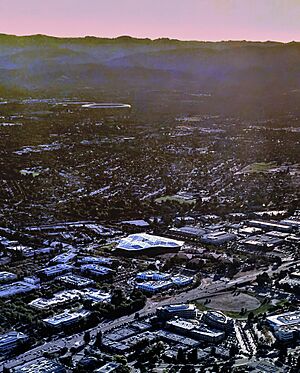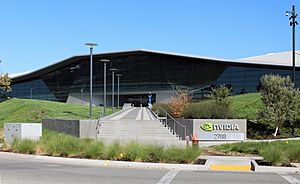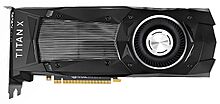Nvidia facts for kids

Headquarters in Santa Clara, California, in 2023
|
|
|
Trade name
|
NVIDIA |
|---|---|
| Public | |
| Traded as | |
| Industry | |
| Founded | April 5, 1993, in Sunnyvale, California, U.S |
| Founders |
|
| Headquarters |
,
U.S
|
|
Area served
|
Worldwide |
|
Key people
|
|
| Products |
|
| Revenue | |
|
Operating income
|
|
| Total assets | |
| Total equity | |
|
Number of employees
|
29,600 (FY 2024) |
| Subsidiaries |
|
Nvidia Corporation is a big American technology company. It is based in Santa Clara, California. Nvidia is famous for designing and making powerful computer chips. These chips are called graphics processing units, or GPUs.
Nvidia's GPUs are used for many things. They help create amazing graphics in video games. They are also used in supercomputers and special workstations. These powerful computers help with things like engineering, movie making, and scientific research. Nvidia also makes chips for artificial intelligence (AI) and self-driving cars.
The company has also created gaming devices like the Shield Portable and Shield Tablet. They even have a cloud gaming service called GeForce Now. Nvidia also makes software that helps GPUs work together. This software is called CUDA. It allows computers to solve very complex problems quickly.
Nvidia is a very successful company. In 2023, it became one of the few companies worth over $1 trillion. By June 2024, Nvidia was the most valuable company in the world.
Contents
History of Nvidia
How Nvidia Started

Nvidia was started on April 5, 1993. Three friends, Jensen Huang, Chris Malachowsky, and Curtis Priem, created it. They met at a Denny's restaurant in San Jose, California, to plan the company.
The founders believed that computers would need special chips for graphics. They thought video games would be a great way to use these chips. Jensen Huang said that video games were a "killer app." This meant they would help fund lots of research and development.
They started with $40,000 and later got $20 million from investors. In the 1990s, many companies tried to make graphics chips for games. Only two survived: Nvidia and AMD.
The company's first name idea was NVision. But that name was already taken. So, Jensen Huang suggested "Nvidia," which comes from the Latin word for "envy."
First Graphics Chip Challenges
Nvidia's first graphics chip was called the NV1. It was made for a different type of graphics than what Microsoft decided to support. Microsoft's new software, DirectX, only worked with triangles, not the shapes Nvidia used.
Nvidia also had a deal with Sega to make a chip for the Dreamcast game console. But their technology was behind. Sega decided to use another company's chip. However, Sega's president, Shoichiro Irimajiri, still believed in Nvidia. He invested $5 million in the company. This money kept Nvidia going for six more months.
In 1996, Jensen Huang had to let go of more than half of Nvidia's employees. The company had about 100 people, and he kept only 40. They focused on making a new chip that worked with triangles. This new chip was called the RIVA 128.
When the RIVA 128 came out in 1997, Nvidia had very little money left. Their unofficial motto became: "Our company is thirty days from going out of business." But the RIVA 128 sold very well. Nvidia sold about a million chips in four months. This success helped them make new products. In 1998, the RIVA TNT chip made Nvidia famous for great graphics.
Becoming a Public Company
Nvidia became a public company on January 22, 1999. This meant people could buy shares of the company. Sega's investment in Nvidia turned out to be a great decision. Sega later sold its Nvidia shares for $15 million.
In late 1999, Nvidia released the GeForce 256. This was their first product called a GPU. It was very advanced for its time. The GeForce 256 was much faster than other chips.
Because of its success, Nvidia got a deal to make the graphics hardware for Microsoft's Xbox game console. This deal brought Nvidia $200 million. In 2000, Nvidia bought 3dfx, a company that was a big competitor in graphics.
Over the next few years, Nvidia bought other companies. They bought Exluna for software tools and MediaQ for mobile chips. They also helped Sony design the graphics processor for the PlayStation 3 game console.
Nvidia's Growth and Challenges (2007–2014)
Forbes magazine named Nvidia its "Company of the Year" in 2007. This was because of their great achievements. In 2008, Nvidia bought Ageia, a company that made PhysX technology. PhysX helps games create realistic physics.
In 2008, Nvidia had a problem with some of its chips. Some mobile chips and GPUs had "abnormal failure rates." This meant they broke down too often. Nvidia had to pay about $200 million to fix this. They also settled a lawsuit about these faulty chips.
In 2011, Nvidia released the Tegra 3 chip for mobile phones and tablets. They said it was the first quad-core mobile CPU. In 2013, they showed off the Tegra 4 and the Nvidia Shield, a handheld gaming device.
Nvidia also started building a new headquarters in 2013. The buildings are shaped like triangles. Jensen Huang said this is because triangles are the basic building blocks of computer graphics.
By 2014, Nvidia started focusing on three main areas: gaming, car electronics, and mobile devices.
New Technologies and Partnerships (2016–2018)
In 2016, Nvidia launched its GeForce 10 series GPUs, like the GTX 1080. These new chips were much faster and used a new design. They also helped improve virtual reality graphics.
Nvidia partnered with Toyota in 2017 to use Nvidia's Drive PX-series AI platform for self-driving cars. They also teamed up with Chinese company Baidu for AI in cloud computing and autonomous driving.
In 2018, Nvidia released the RTX 2080 GPUs. Google also announced that Nvidia's Tesla P4 graphics cards would be used in Google Cloud for AI.
There was a disagreement between Nvidia and Apple Inc. around this time. Apple stopped supporting Nvidia graphics cards in its macOS Mojave operating system. This meant users with Nvidia cards in older Mac computers couldn't get the best performance.
Big Acquisitions and AI Focus (2019–2023)

In 2019, Nvidia announced it would buy Mellanox Technologies for $6.9 billion. This helped Nvidia grow in the area of high-performance computing. Nvidia also released new RTX Studio laptops for creative work. They also added real-time ray tracing to the game Minecraft.
In 2020, Nvidia bought Cumulus Networks. They also created an open-source ventilator to help during the COVID-19 pandemic. Nvidia then announced its new Ampere GPU design and the A100 GPU accelerator.
In September 2020, Nvidia announced the GeForce 30 series graphics cards. These were based on the new Ampere design.
Nvidia tried to buy Arm, a UK-based chip designer, for $40 billion. But this deal didn't happen. Governments around the world had concerns about it.
In 2020, Nvidia also announced plans to build a supercomputer in England called Cambridge-1. It uses AI to help with healthcare research.
In 2022, Nvidia's CEO said they might have Intel make their chips in the future. This was a big step, as Intel is a competitor. Nvidia also opened a new research center in Yerevan, Armenia.
In 2022, the U.S. government put limits on selling advanced chips to China. Nvidia then made a new chip for China that followed these rules.
In 2023, Getty Images partnered with Nvidia to create an AI tool for making images. Also in 2023, Nvidia's H100 GPUs were in very high demand. Even other big tech companies were asking Nvidia for these chips.
Recent Developments (2024)
In 2024, Nvidia increased its efforts to talk with lawmakers in Washington, D.C., about AI rules.
Nvidia's H100 GPUs were selling for $25,000 to $30,000 each. Some even cost over $40,000 online. Big tech companies were buying thousands of these chips for their AI projects.
Nvidia became a very popular employer in Silicon Valley. Many employees earned over $228,000 in 2023. Nvidia GPUs are so valuable that they need special security when being shipped.
On March 1, 2024, Nvidia's value reached over $2 trillion. It was the third U.S. company to do this. Nvidia reached this value much faster than Apple and Microsoft. In June 2024, Nvidia's value reached $3 trillion. It then became the world's most valuable public company.
How Nvidia Makes Chips
Nvidia does not make its own chips in factories. Instead, it hires other companies to do the manufacturing. This is called "fabless manufacturing." Nvidia focuses its efforts on designing the chips, making sure they are high quality, and selling them. This way, Nvidia avoids the huge costs of building and running chip factories.
Nvidia's Leadership
Nvidia has a team of leaders who guide the company.
- Jensen Huang is the founder, president, and CEO.
- Chris Malachowsky is also a founder and an NVIDIA fellow.
- Colette Kress is the chief financial officer.
- Jay Puri leads worldwide sales.
- Debora Shoquist is in charge of operations.
- Tim Teter is the general counsel and secretary.
GPU Technology Conference
Nvidia hosts a series of events called the GPU Technology Conference (GTC). These conferences are held around the world. They started in 2009.
GTC used to focus on how GPUs could solve computing problems. Now, it mainly focuses on artificial intelligence and deep learning. Topics include self-driving cars, healthcare, and high-performance computing. Thousands of people attend GTC each year to learn about new technologies.
Nvidia's Products
Nvidia makes many different products. These include graphics chips, wireless devices, and car hardware and software.
- GeForce chips are for everyday users, especially for gaming.
- Nvidia RTX chips are for professional graphics and design work.
- Tegra chips are used in mobile devices like smartphones and tablets.
- Tesla chips are powerful GPUs for scientific research and professional use.
- Nvidia Shield is a line of gaming devices, including handhelds and TV accessories.
- Nvidia Drive products are for designing and building self-driving cars.
- Nvidia BlueField chips are for data centers.
- Nvidia Grace is a new type of CPU for data centers.
Open-Source Software Support
For a long time, Nvidia did not share much information about its hardware. This made it hard for programmers to create free and open-source software drivers for Nvidia products.
Nvidia usually provides its own special drivers. Many users who prefer open-source software were not happy about this. Other companies like Intel and AMD share more information with open-source developers.
However, in May 2022, Nvidia announced that it would make its GPU kernel modules open source. This was a big step. It helps open-source developers create better drivers for Nvidia graphics cards.
Deep Learning and AI
Nvidia GPUs are very important for deep learning and artificial intelligence. This is because of Nvidia's CUDA software. CUDA allows programmers to use the many cores in GPUs to do many calculations at once. This makes AI algorithms much faster.
Nvidia GPUs are used by researchers, labs, and tech companies. In 2009, Nvidia GPUs helped make a big breakthrough in deep learning. Researchers found that GPUs could make deep-learning systems 100 times faster.
DGX Supercomputers
DGX is a line of powerful supercomputers made by Nvidia.
In 2016, Nvidia created the DGX-1. It combines GPUs with special software for deep learning. Nvidia gave its first DGX-1 to OpenAI to help them train complex AI models. This reduced the time needed for training from six days to just two hours.
Nvidia also works with companies like Google Cloud and Microsoft to provide GPU servers. They also partnered with IBM to improve the AI abilities of Watson.
Robotics
In 2020, Nvidia launched "Omniverse." This is a virtual world for engineers to design and test things. Nvidia also made Isaac Sim open-source. Isaac Sim uses Omniverse to train robots in realistic simulations.
Nvidia's CEO, Jensen Huang, believes that humanoid robots and self-driving cars will become very common in the future. Nvidia is focusing on these areas.
Inception Program
Nvidia's Inception Program helps new companies (startups) that are making big progress in artificial intelligence and data science. Award winners are announced at Nvidia's GTC Conference. By 2021, the program had over 8,500 companies from 90 countries.
See also
 In Spanish: Nvidia para niños
In Spanish: Nvidia para niños
- Fast approximate anti-aliasing
- General-purpose computing on graphics processing units
- Huang's law
- Molecular modeling on GPUs
- GPU workstations
Images for kids





